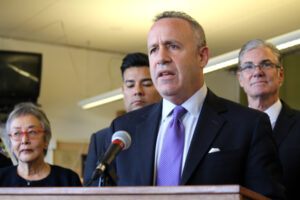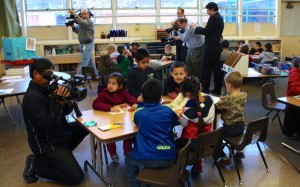
Transitional kindergarten students Sean Whitfield and Madison Her, both 5, eat lunch at H.W. Harkness Elementary School in Sacramento, where Senate Democrats unveiled a new bill that would expand the program to all 4-year-olds. Credit: Lillian Mongeau, EdSource
Highlighting early education as a top priority, Senate Democrats have introduced a bill that would create a new grade level – a pre-kindergarten program for 4-year-olds – in California’s public schools.
“This is at the top of the list. I can’t think of anything more important,” Senate President pro Tempore Darrell Steinberg said at a news conference announcing the new bill Tuesday.
Steinberg joined with 10 of his Senate colleagues in proposing that the state’s transitional kindergarten program, which currently serves only a small number of California’s nearly 500,000 4-year-olds, be expanded to accommodate all 4-year-olds in the state wishing to enroll. Under the proposal, the expansion would begin to roll out in the 2015-16 school year and would accommodate all eligible students by the 2019-20 year.
Steinberg said the anticipated cost of the expanded program, $990 million per year once it’s fully implemented, was “modest” and easy to defend as a worthy investment of public money. Advocates of the program point to research suggesting that children who attend preschool are more likely to graduate high school and less likely to commit crimes, thereby increasing their earning potential and reducing their cost to society.
Transitional kindergarten was offered for the first time during the 2012-13 school year as an extra grade level for children who turn 5 during the first three months of the school year and are too young for traditional kindergarten. When the program is fully implemented next fall, only about a quarter of the state’s children will be eligible to participate, based on the current age restrictions.
The Senate proposal would create a half-day transitional kindergarten program for all 4-year-olds.
Money to pay for the new program would come from revenues set aside under the voter-approved Proposition 98, which sets a minimum funding guarantee for the state’s schools. Steinberg said schools are projected to have an additional $7.1 million for Prop. 98 in the budget year that starts July 1. However, other educational programs will be vying for those dollars as well, including community colleges and K-12 districts.
The proposal, introduced as Senate Bill 837, the Kindergarten Readiness Act of 2014, follows a similar proposal from the Assembly Democratic Caucus, which identified universal transitional kindergarten among its priorities in its “budget blueprint” for the coming year. The proposals potentially carry significant weight in the Democrat-controlled Legislature, where Republican support is not needed to pass a budget.
Gov. Jerry Brown had no comment on the new bill, a spokesperson for his office said Tuesday. Brown is expected to release his 2014-15 budget proposal on Friday.

Senate President pro Tem Darrell Steinberg, D-Sacramento, announces a bill to create a universal pre-kindergarten program for 4-year-olds at H.W. Harkness Elementary School in Sacramento. Joining him at the press conference are, from left, Sen. Carol Liu, D-La Cañada Flintridge, Sen. Ricardo Lara, D-Long Beach, and state Superintendent Tom Torlakson. Credit: Lillian Mongeau, EdSource
Steinberg said he’s had “good conversations” with the governor regarding the new legislation. But Sen. Holly Mitchell, D-Los Angeles, chair of the Black Caucus and a supporter of the bill, was less optimistic about the governor’s likely support. Early education, she said, “is not an area (Brown) has been sensitive to.”
Republican Minority Leader Bob Huff, R-Diamond Bar, wasn’t ready to support the proposal, noting that he hadn’t yet seen any evidence that transitional kindergarten improved academic outcomes for children. Huff was also wary of any new spending measures, despite California’s sunnier fiscal outlook.
“Legislators will introduce many new spending proposals this year on a variety of policies that may sound wonderful,” Huff said. “The most responsible action is to look at all of them and then prioritize based on available resources rather than committing to new spending right now.”
State Superintendent of Public Instruction Tom Torlakson, a sponsor of the bill, said the new proposal would not take money away from existing funding for early childhood care and education. On the contrary, he said, expanding transitional kindergarten would allow existing state programs to concentrate on serving children younger than 4.
The proposed program would last three hours. Torlakson suggested that the state-funded preschool program, targeting low-income 3- and 4-year-olds, could work with public schools to provide care and education to students for the other half of the day. Students would spend that time in a classroom of no more than 20 students under the care of one credentialed teacher and one associate teacher with training in early education, according to the language of the bill. The expansion would create 8,000 new jobs for credentialed teachers and 12,000 new jobs for associate teachers, according to a spokesperson for Liu.
Finding teachers likely won’t be a problem in Riverside, said Judi Paredes, the assistant superintendent for elementary instruction at Riverside Unified School District. Finding space to house a new grade’s worth of students could be tougher, she said.
Anticipating potential impacts on classroom availability, the bill specifies that facilities bonds could be used to build transitional kindergarten classrooms. Private preschool (or early education) providers that meet quality standards could also be used to supply transitional kindergarten services, according to the bill, another possible release valve for overcrowded schools.
Despite the challenges, Paredes said an extra year of school would be a good thing for children in her district.
“If the curriculum is developmentally appropriate for 4-year-olds, I would predict that by 1st grade we’d see higher levels of achievement,” Paredes said.
Operating a program that served all 4-year-olds would actually be an easier task than running a program for a small portion of the population, as the current transitional kindergarten legislation mandates, Paredes said.

Following the introduction of a bill to expand transitional kindergarten to all 4-year-olds, transitional kindergarten teacher Michelle Cazel-Mayo’s classroom at H.W. Harkness Elementary School in Sacramento gets a visit from the media. Credit: Lillian Mongeau, EdSource
Were the Kindergarten Readiness Act of 2014 to become law, it would bring California to the forefront of the universal preschool movement, joining states like New Jersey, Oklahoma and Georgia, which offer universal preschool for 4-year-olds. It would also qualify the state for funding under federal legislation proposed in the House and Senate that would provide grants to states interested in expanding their public preschool offerings.
Public preschool in California is currently a patchwork affair. Head Start, a federal program, and a state-funded preschool program serve about 50 percent of the state’s 4-year-olds. The rest either stay home or attend private programs that can run parents around $15,000 a year, though prices vary widely across the state. Some districts, like San Francisco Unified, Los Angeles Unified, Long Beach Unified and Fresno Unified, have started their own public preschool programs with funding streams from various sources.
Mike Hanson, Fresno’s superintendent, was enthusiastic about the notion of enrolling all of his city’s 4-year-olds in transitional kindergarten.
“It makes tremendous sense for us in Fresno,” Hanson said. “This is the poorest city in California. Getting to universal (enrollment) and having the resources to back it would be a huge advantage for us.”
Hanson was less impressed with what sounded to him like the overly prescriptive nature of the proposed bill. The legislature needs to offer districts maximum flexibility in implementing to programs, Hanson said.
“Fund us to get 4-year-olds into school, but don’t tell us how to staff a classroom,” he said. “That’s the local education board’s purview.”
To get more reports like this one, click here to sign up for EdSource’s no-cost daily email on latest developments in education.












Comments (7)
Comments Policy
We welcome your comments. All comments are moderated for civility, relevance and other considerations. Click here for EdSource's Comments Policy.
Annette Lee 10 years ago10 years ago
Funding concerns aside... the phase-in approach is wrong. So what will happen is this: for the next 5 years, half of Johnny's kindergarten class - the older half - will have had a full year of TK by the time he and his younger classmates (the ones who didn't meet the age window) join them in traditional kindergarten. This is setting up Johnny to be at a major disadvantage. He needs to have a … Read More
Funding concerns aside… the phase-in approach is wrong.
So what will happen is this: for the next 5 years, half of Johnny’s kindergarten class – the older half – will have had a full year of TK by the time he and his younger classmates (the ones who didn’t meet the age window) join them in traditional kindergarten. This is setting up Johnny to be at a major disadvantage. He needs to have a fair chance to learn along side his classmates. How is this fair to our younger 5-yr-olds? Are parents supposed to now hold Johnny back a year and start him in traditional kindergarten when he is 6 just to level the playing field?
ALL children who will be starting kindergarten together should have the opportunity to start TK together as well. Anything else is completely unfair to the next 5 years of our youngest kindergartners.
Mike McMahon 10 years ago10 years ago
Looks like other states are looking at early child education and universal kindergarten. http://hechingerreport.org/content/how-universal-will-de-blasios-universal-pre-k-be_14425/
Mike McMahon 10 years ago10 years ago
On a policy level, the push to implement TK is sound. Research has shown that the Early Childhood Education benefits especially for underserved populations outweigh the cost, so it is a good investment. However, from a state fiscal perspective it is disingenuous. During every recession during K-12 education suffers severe funding reductions and the Legislature lets local school districts to figure how to make program cuts. But once the economy recovers and revenues start to recover … Read More
On a policy level, the push to implement TK is sound. Research has shown that the Early Childhood Education benefits especially for underserved populations outweigh the cost, so it is a good investment.
However, from a state fiscal perspective it is disingenuous. During every recession during K-12 education suffers severe funding reductions and the Legislature lets local school districts to figure how to make program cuts. But once the economy recovers and revenues start to recover the Legislature steps in and begins to dictate how to spend those new revenues and does not give local school districts an opportunity to choose to restore cut programs. After the early 1990s recession, new monies were directed to Class Size Reduction. After the 2003 recession, new monies were directed to a Quality Education Initiative which only benefited certain school districts.
In 2014, the proposal to direct new monies to TK is even more perplexing. The great recession of 2008 was the most severe reduction in K-12 funding ever. Only after the passage of Prop 30, a temporary tax hike has funding for K-12 stabilized. It will be 2015 before funding levels reach pre-recession levels of 2008. The Governor took the opportunity of projected future revenues to radically change how school districts through Local Control Funding Formula (LCFF). The central premise of LCFF is that local school districts will given greater local control. However, the transition to this new funding formula is planned to take eight years. After the Governor leaves office the taxes will expire, and there are no assurances there will be enough revenues to continue the transition. And now the Legislature is proposing to divert one billion dollars of ongoing cost away from the implementation of LCFF. Really!?
Replies
Fred Jones 10 years ago10 years ago
I totally concur, Mike. This is the mother of all Categoricals, which I thought LCFF was suppose to eliminate (trusting districts to the right thing)! While state policymakers should consider statewide priorities that districts may lose sight of, is this particular issue worthy of establishing a new Categorical funding stream to establish? What about prior Categorical programs that have been wiped off the state ledger books, like Career Technical Education? Clearly the state has an … Read More
I totally concur, Mike. This is the mother of all Categoricals, which I thought LCFF was suppose to eliminate (trusting districts to the right thing)!
While state policymakers should consider statewide priorities that districts may lose sight of, is this particular issue worthy of establishing a new Categorical funding stream to establish?
What about prior Categorical programs that have been wiped off the state ledger books, like Career Technical Education? Clearly the state has an interest in preparing the workforce of tomorrow to replace the quickly depleting workforce of the baby-boom generation, yet nobody seems to be talking about reestablishing CTE’s state funding streams (in fact, under LCFF and the Gov’s proposal for next year, nearly a half-billion of CTE dollars will be cut, leaving only $21.4M for Partnership Academies).
Diana Chun 10 years ago10 years ago
Hi Laura and Linda, I was happy to read that both of you have seen firsthand the value of transitional kindergarten for young children. I work at Early Edge California, a non-profit advocacy organization working to ensure all children have the early experiences necessary to be successful learners by the end of 3rd grade, setting them on a path to college and career readiness. We always need stories that provide a human face to this issue when … Read More
Hi Laura and Linda, I was happy to read that both of you have seen firsthand the value of transitional kindergarten for young children.
I work at Early Edge California, a non-profit advocacy organization working to ensure all children have the early experiences necessary to be successful learners by the end of 3rd grade, setting them on a path to college and career readiness.
We always need stories that provide a human face to this issue when we talk to the media or policymakers – if you’re willing to share your story with us, please let me know. You can reach me at dchun@earlyedgecalifornia.org or (510) 271-0075 ext. 303. Thank you both!
linda ulrich 10 years ago10 years ago
This program featured in this article is wonderful. My nephew is a student in the program and the experience and learning has helped him tremendously.
Laura Dunn 10 years ago10 years ago
This is very exciting news, as I am a TK teacher who has implemented this program since the fall of 2012 and it has been very successful! it makes the Kindergarten experience for them a lot easier and they are much more prepared to deal with the new demands of Common Core testing in 3rd grade.